Field Equipment
Field Equipment - When we think of coaching little league youth baseball teams, we focus on all the drills, techniques and skills we want to teach our players.
We give our undivided attention to everything pertaining to playing the game except one, the Field. The ball park, where we’ll create memories which will last a lifetime, hardly ever crosses our minds until we show up to practice, when the hard reality of a lousy baseball field hits us right between the eyes.
If you’re from a wealthy enough association which can pay an outside source to maintain your fields this section will have little interest for you, but if you’re like most baseball associations, a large part of the field maintenance is performed by the coaches and volunteers.
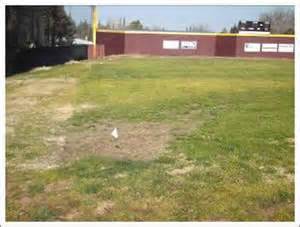
Abandoned Field
In this section we’re going to exam the field equipment required to properly maintain the ball park, create new fields and an overall view of what it takes to efficiently operate the maintenance of a baseball park throughout the season.
Field Equipment - The Awful Beginning
You initial visit to the ball park in March is nearly gut wrenching. The grass and weeds have overgrown the outfield, infield, dugouts and fence perimeter. The infields have patches of weeds growing, but the deep ruts left by some kid doing donuts in the mud with his 4 wheeler holds your attention the longest.
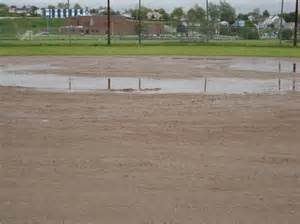
Terrible Drainage
Netting is torn, portions of the outfield fence are loose and the 10’ high yellow foul poles resemble the leaning tower of Pizza. Where in the world do you begin?
Field Equipment - The Plan
Not unlike any other construction project you must have a plan of action or else you’ll just have a group of volunteers milling around talking about how they’ll never do this again, and numbers of hands are important.
Take stock of the Field Equipment you must have in order to perform a professional appearing job in a short period of time.
A good tractor with preferably a belly mower, because it does a nicer looking job, or a brush hog. The tractor should have a front end loader and a PTO for attachments. This will be your most important, and most expensive, piece of equipment, but essential to do the job.
Groomers, pieces of equipment designed to smooth the surface of the infielder, tractor pulled and hand pulled are required. A riding and push lawn mower as well as several gas power weed trimmers are needed.
A weighted roller is very nice to have for leveling high spots and hand rakes, both regular grass combing and field combing types. Throw in the normal hammer, nails, paint brushes and cleaning equipment and you’re ready to begin.
Most Important
Addressing the infield condition is the first step to undertake. The outfield will be dealt with later, but the reconditioning of the infield is the initial project.
We’ll assume the field is a multi-purpose field which teams of older ages play. The first thing is to re-establish the infield parameters, which will tell us where we should start removing grass and weeds which have taken root.
It’ll also tell us where to stop removing the grass to insure a clean cut line of where the outfield begins.
We need to lay the infield out in order to properly measure the locations of everything we’re going to address. Assuming the home plate is embedded in concrete and unmovable, that is where we’ll begin our layout.
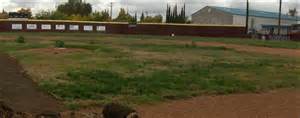
Using the back corner of home plate as the benchmark, use a tape and measure 127’ & 3 3/8 inches, place a wooden stake at this spot, which represents the center of second base.
While the tape is stretched out, measure 60’ 6” from the back of home plate, this is where the pitching rubber will be installed. We know the pitching rubber will be adjusted for different age brackets, but we need to establish the major league distance at the moment.
Using two tape measurers is the quickest and easiest way to locate first and third base. From the back of home plate measure 90’ down the first base line, from the wooden stake at second base, measure 90’ to first base. Where the two tapes Intersect is the back corner of first base.
Repeat these steps for locating third base.
The infield dimensions are set, now we’ll locate the edge of the outfield grass. Cut a piece of strong string, 95’ long and secure it in front of the pitcher rubber. (remember we needed the 60’ 6” measurement)
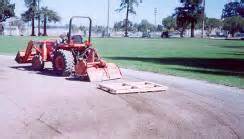
Field Equipment - Tractor & Drag Are A Must
From that point draw an arc beginning at third base around the entire infield to first base. If there isn’t much foliage in the infield, simply use something to scrape the infield dirt to indicate the perimeter, if there’s a lot of grass and weed, use a cheap can of white spray paint to mark as you go along. All grass and weeds must be removed from the inside of the marking in order to give you a grass free infield.
Tractor Power
After the grass and weeds have been removed, we need to install a box scraper or other devise on the back of the tractor. Using the scraper drive back and forth, round and round the entire infield including foul territory and behind home plate.
This will knock any high spots in the field down and should leave a level surface. You’re finished with the infield for the moment.
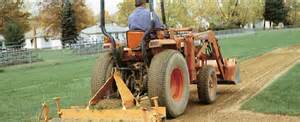
Take the scrapper off the tractor, install the mower and mow the entire outfield. Depending on the amount, if clumps of mowed grass are abundant after mowing, attempt to mow again, or rake the grass and remove it, it can not stay on the field.
Using gas powered weed trimmers have the fences, dugouts and walkways cleared and raked. Raking such large areas can be troublesome and time consuming, but it’s better to do it right one time, than constantly deal it through the season.
Your baseball field is suddenly beginning to resemble a baseball field again.
Field Equipment back to Baseball Diamond

New! Comments
Have your say about what you just read! Leave me a comment in the box below.